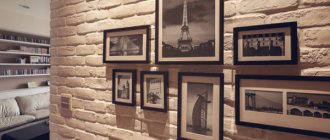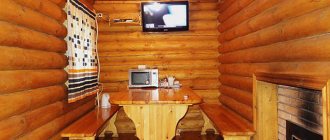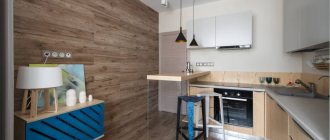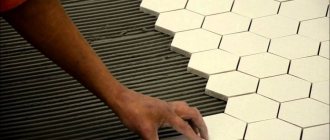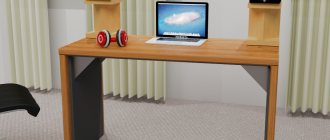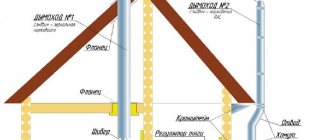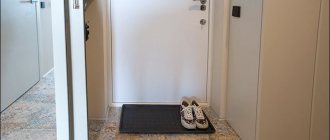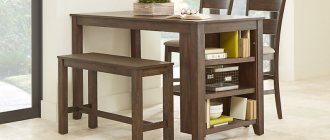The old bulky cathode ray tube televisions were gradually replaced by modern flat-panel designs based on new technologies. There are more opportunities for their most convenient placement in suitable places. For these purposes, special brackets have been created that allow you to mount the device on a wall or ceiling. Next, we’ll talk about how to choose the right bracket for a TV, consider what types of brackets there are and a rating of the best.
Types of brackets
In order to choose the right bracket, it is necessary to study the main types of these structures. Among them are the following types:
- Fixed . They are a static element that secures the TV to the wall in a stationary position. Structurally, they are made in the form of a small metal plate or a common guide on which two supports are located.
- Oblique . Outwardly they resemble a fixed structure. They are distinguished by the presence of a regulator that changes the tilt from 10 to 30 degrees. Due to this, glare is removed from the screen, regardless of height.
- Tilt-rotary . Can be adjusted in vertical and horizontal directions. The design is ideal for walls with complex architectural designs.
Many brackets allow you to change the distance from the wall to the TV. The device can be extended to the desired distance for the viewing period, and then returned to its original position. The removable mounting plate may have two parts. First, the support or frame is attached to the TV, after which it is connected to another element that is previously screwed to the wall. Massive heavy screens are installed in this way.
Some models have cable channels where you can hide all the wires, as well as a built-in level that allows you to accurately align the TV horizontally.
The Best Inexpensive TV Mounts
Budget brackets are mounts with limited functionality. The category includes models costing from 300 to 10,000 rubles, which differ in the way they are adjusted: fixed, tilted, and rotating.
Tuarex Olimp-407
5
★★★★★
editorial assessment
97%
buyers recommend this product
The tilt-and-swivel bracket has good functionality, considering its affordable price. It allows you to adjust the TV's tilt from +10 to -12°, rotate it by 120°, and also adjust the screen horizontally by 3°.
Thanks to this functionality, the mount allows you to adjust the optimal position of the TV in any part of the room. There is a water level on the bracket body, which greatly simplifies installation and allows you to check whether the TV weighs evenly. There is also a groove for the antenna cable. The maximum load of the model is 35 kg.
Advantages:
- Adjustable tilt and swivel;
- Water level;
- Cable groove;
- Reinforced design;
- Screen adjustment.
Flaws:
- Heavy weight.
The Olimp-407 mount from Tuarex is suitable for TVs with a diagonal of 26–55 inches.
Arm Media Paramount-70
4.9
★★★★★
editorial assessment
93%
buyers recommend this product
The durable and reliable bracket can be used for TVs with a diagonal of 32 to 90 inches. Its maximum load is 65 kg, which makes the Paramount universal for equipment with any VESA mounting holes - from 75x75 to 600x400.
The model is equipped with a telescopic mechanism, which makes it possible to adjust the distance from the wall in the range of 69–635 mm. The mount has a standard rotation angle of 120°. The tilt can be changed within +5.. -15°.
The bracket is made of durable steel, painted black, so it will be invisible in the interior. The presence of cable channels makes the mount practical to use.
Advantages:
- Greater resistance to loads;
- Versatility;
- Cable channels are provided;
- Telescopic mechanism;
- Laconic design.
Flaws:
- Without water level.
Arm Media's Paramount-70 mount is suitable for home and office use. A universal option for those who are not very versed in selecting TV brackets.
Onkron M4
4.8
★★★★★
editorial assessment
89%
buyers recommend this product
Onkron M4 combines elegant design, good build quality and affordability. The model is quite universal, as it can be used with most TVs with a diagonal from 32 to 65 inches, suitable for both flat and curved screens.
The bracket can withstand loads of up to 35 kg and complies with VESA mounting standards from 100x100 to 400x400. The mount extends from the wall to a distance of up to 50 cm (minimum 5 cm).
The model comes complete with plastic covers that hide the cables. The bracket body is painted white, made of SPCC grade steel and has ultra-thin elements.
Advantages:
- Stylish design;
- Versatility of use;
- Compatibility with curved screens;
- Decorative overlays;
- Slim profile.
Flaws:
- Small angle of inclination.
The M4 bracket from Onkron will fit harmoniously into the interior of a modern home. Suitable for almost any TV with good viewing angles.
Kromax Galactic-12
4.7
★★★★★
editorial assessment
86%
buyers recommend this product
One of the most budget brackets in the line has tilt-and-turn adjustment. It is designed to mount TVs with a screen diagonal of 15-42 inches with a VESA mounting hole standard from 75x75 to 200x200.
The bracket is made of steel and can withstand loads of up to 25 kg. The model has a wide rotation angle of 180 degrees, which allows you to more accurately adjust the position of the TV. Vertical adjustment is +3..-10°. The mount is easy to set up and has a simple installation system.
Advantages:
- Easy;
- Easy adjustment;
- Wide rotation angle;
- There is a hole for the cable;
- Laconic design.
Flaws:
- Low load capacity.
The Galactic-12 mount from Kromax is a cost-effective solution for mounting small TVs.
READ ALSO
10 Best Projection Screens
Do all brackets fit TVs?
When purchasing a bracket, it is important not to make a mistake with the choice of design. There are useful recommendations in this regard that must be taken into account:
- Compare the weight of the TV with the maximum permissible weight that the bracket can support.
- Clarify the warranty conditions for the selected design and possible replacement options.
- Select the correct mounting configuration depending on the operating conditions. Basically, preference is given to rotating structures with varying angles of inclination.
- Check the completeness - the presence of bolts, fasteners and other components.
- Decide whether to purchase an expensive automatic bracket with remote control. It is advisable to buy such designs for large TVs that are difficult to move manually.
- The mount and TV must comply with the VESA standard, which is specially designed to streamline mounting and installation. Most of them are completely consistent with each other, you just need to carefully select the appropriate option.
If your TV has a non-standard mount, you should choose universal mounts that are suitable for almost all models.
Pros and cons of a TV bracket
Television has become an integral part of our lives, and in order to watch your favorite TV shows comfortably, you need to install the TV correctly. For these purposes, special options are used - brackets.
With their help, you can install the device for watching programs on any vertical surface. Thanks to this technique, it will be possible not only to visually increase the space, but also to protect the panel from accidental damage.
If the mount has a rotating mechanism, then the screen can be rotated and installed at the most favorable angle.
The bracket has its advantages and disadvantages. The advantages include:
- Compactness – when using a bracket, free space is saved.
- Affordable price – small models of wall brackets have a low cost.
- Possibility to choose the mounting angle - most models have a rotating mechanism.
- There is no need to select a bracket to match your interior design. Fastening elements are hidden behind the TV panel.
- Safety - if the installation of fasteners and subsequent mounting of the TV is done correctly, then the danger of overturning the “plasma” disappears.
If the mount has a rotating mechanism, then the screen can be rotated and installed at the most favorable angle.
This method also has its disadvantages:
- If the accessory is of poor quality or the installation process is not carried out according to the rules, there is a risk of the screen falling and injuring others.
- To perform correct installation you need to have certain skills and knowledge.
- If you need to remove the bracket, there will be marks on the wall that need to be hidden.
Please note that once installed, you cannot change the location without additional costs.
How to choose a TV wall bracket
The selection of the most suitable design is carried out according to certain criteria, taking into account the technical characteristics of the bracket and the TV itself.
- Installation location. Before choosing and purchasing a bracket, you should decide in advance where the TV will be installed. If you will use a mount to a wall located opposite a chair or sofa, in this case it is recommended to use a fixed model. If the screen position is too high, exceeding the level of view, an inclined or rotating structure should be installed. The same applies when the TV is located in the corner of the room. Failure to comply with this rule will cause rapid eye fatigue and increased strain on the neck.
- Maximum load . This is a very important parameter, since the weight of the TV should in no case be greater than the carrying capacity of the bracket. If a heavy product is attached to a weak mount, it simply won’t hold up and will break, and expensive electronics will fall from a height and break. Most often, it can no longer be restored.
- Angle of tilt or rotation . The structure must rotate in different directions with the amplitude required in real operating conditions. Actual performance may differ from the specifications declared by the manufacturer.
- Bracket weight . This indicator must be taken into account if it is planned to use interior partitions for installation. Such a wall is considered too light and not designed for increased loads. The weight of the structure along with the TV may be too much for such a place, and sooner or later the bracket will simply fall out. In the worst case scenario, the partition itself may crack and require serious repairs.
How to properly attach the bracket
Experts recommend following a number of tips during installation:
- In addition to all of the above, the distance between the screen and the eyes of the intended viewer is also important. It is better that it be at least 2.5 meters (for a diagonal of 32 inches). If the screen is larger, then the distance is selected to be increased (40 inches - 3 meters, 55 inches - 4 meters).
- Adequate ventilation should be ensured to prevent overheating. Otherwise, the device will quickly fail.
- Cooking surfaces, electric heaters and electric fireplaces should be kept as far as possible from the TV to prevent exposure to heat and radiation.
- Before carrying out work, make sure that the bracket fits the TV, the wall is strong enough and all the necessary elements are available.
- Placing the screen directly opposite the window is also not recommended. On sunny days there will be glare that interferes with viewing and significantly reduces brightness.
Another important factor for selection is the simplicity and accessibility of assembly of the selected fastener. For those owners who decide to install the structure themselves, it would be a good idea to watch the proposed film
Matching the size and area of the room is an extremely important factor. If the screen is too large and the distance is not enough, then the eyes will be overstrained and tired quickly.
How to find out which bracket is needed for a TV
The bracket at its attachment points must exactly coincide with the mounting recesses on the back wall of the TV, determined by VESA standards. The most common sizes are: 10×10, 20×20 and 60×40 cm.
A holder with a large seat width is suitable for any screen due to adjustable dimensions. But there is no way to attach a large-screen TV to a small bracket. Therefore, before purchasing a mount, it is recommended to measure the gaps between the recesses located behind the monitor.
Popular bracket models according to Yandex.Market and customer reviews
As already indicated, there are several basic designs of brackets: fixed, inclined, retractable, ceiling-mounted, tilt-and-turn. Let us now consider the rating of the 10 most popular models of this product according to Yandex.Market and reviews from real customers.
| Brand | Maximum load. Diagonal, inches | Price | Rating |
| Wall bracket ONKRON M4 (inclined) | 35 kg, 32-55 | 1,300 rubles | ★★★★★ |
| Wall bracket ONKRON M5 (inclined) | 36.4 kg, 32-60 | 2,000 rubles | ★★★★★ |
| Wall bracket Arm Media LCD-104 (tilt) | 15 kg, 10-32 | 880 rubles | ★★★★★ |
| Wall bracket ONKRON M15 (tilt) | 45.5 kg, 32-60 | 3,000 rubles | ★★★★★ |
| Wall bracket Kromax OPTIMA-102 (tilt) | 25 kg, 10-28 | 320 rubles | ★★★★★ |
| Wall bracket Kromax ELEMENT-3 (retractable) | 50 kg, 22-65 | 550 rubles | ★★★★★ |
| Wall bracket Kromax CASPER-103 (tilt) | 25 kg, 10-26 | 640 rubles | ★★★★★ |
| Wall bracket Kromax TECHNO-5 (tilt) | 35 kg, 15-55 | 2,110 rubles | ★★★★★ |
| Wall bracket VLK TRENTO-34 (tilt) | 40 kg, 26-65 | 570 rubles | ★★★★★ |
| Wall bracket Trone AK 20 (rotate) | 20 kg, up to 32 | 950 rubles | ★★★★★ |
Thus, for medium-sized TVs, a budget option costing from 500 rubles to 2 thousand is sufficient. Whether to overpay for appearance, beautiful color or additional features is up to you to decide.
